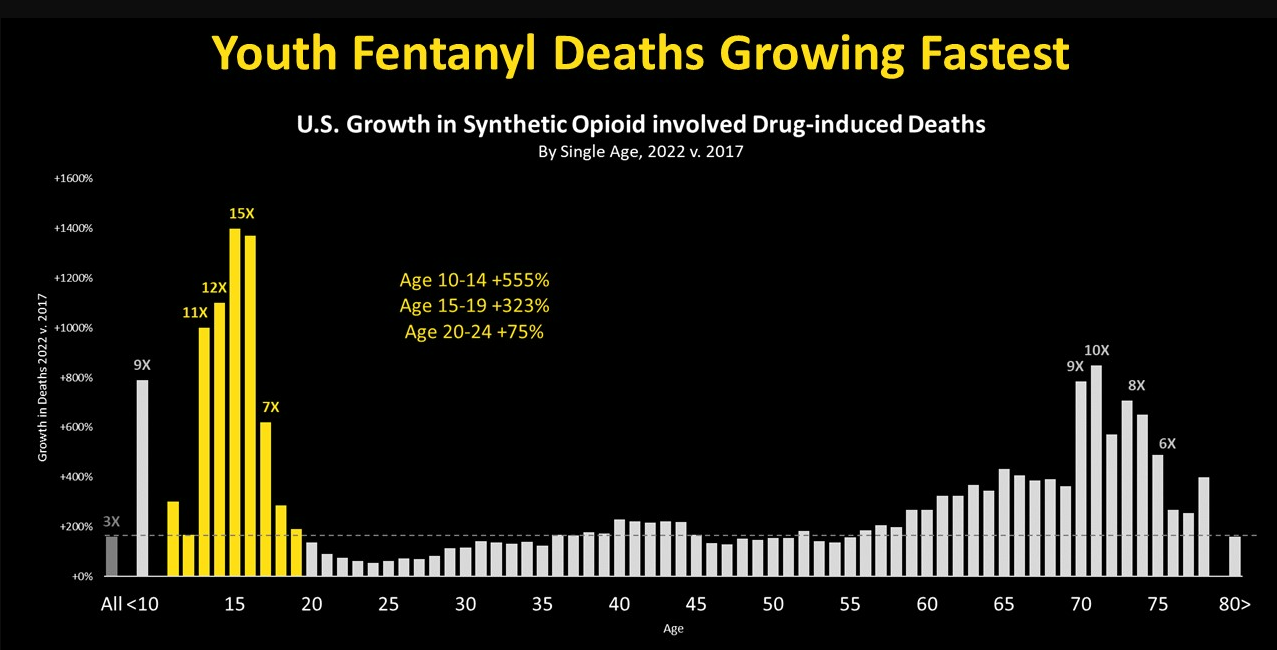- Every year, more young people die of unintentional fentanyl overdoses after consuming counterfeit “fentapills.”
- Drug cartels cut counterfeit pills with fentanyl because it is highly addictive and cheap to make.
- Kids who consume these poorly-made pills often believe they are consuming a legitimate prescription.
- Drug cartels sell these fentapills seamlessly through social media.
Today marks America’s third annual National Fentanyl Awareness Day — both a sober reminder of the lives destroyed by the deadly drug and a renewed call to protect young people from its ravages.
Fentanyl is a synthetic painkiller 50-times more powerful than heroin and 100-times more powerful than morphine. Two milligrams of fentanyl — the equivalent of three grains of salt — can kill someone.
Most of the fentanyl in the United States is manufactured and trafficked by the Sinaloa and Jalisco Nueva Generacion (JNG) cartels.
Fentanyl is highly addictive and cheap to make. When black market demand for drugs like Oxycontin, Percocet and Xanax exceeded cartels’ supply in the 2010’s, they began to create counterfeit pills out of fentanyl.
Seven of every 10 pills seized by the Drug Enforcement Administration (DEA) contain lethal amounts of fentanyl. The DEA has seized more than 17,900,000 fentanyl pills this year alone.
More than 70,000 people died of a fentanyl overdose last year, accounting for more than 60% of the estimated 112,000 deadly overdoses in 2023.
Fentanyl kills an increasing number of young people every year. Fentanyl overdoses for people between 15 and 24 years old more than doubled between 2018 and 2022. Fentanyl overdoses almost quadrupled among 15- to 19-year-olds in the same four years.

CDC Data compiled by Song for Charlie
Young people are unintentionally overdosing on fentanyl after taking counterfeit pills they believe to be other, more regulated drugs.
Cartels sell counterfeit drugs to kids through social media.
A product is advertised using emojis to indicate the type and quantity of drugs being sold. Once a person expresses interest, a sale will be arranged via private messaging apps like WhatsApp. The recipient pays for the drugs via one-step payment apps like Venmo or Zelle.
22-year-old Charlie Ternan died of an accidental fentanyl overdose in 2020, after taking a pill he believed to be the prescription pain-killer Percocet.
According to Charlie’s father, Ed, Charlie had taken Percocet a year-and-a-half ago after he injured his back in a car accident. He had no substance abuse problems or underlying mental health conditions.
Charlie had ordered a single, black-market pill to control his back pain during a job interview. The pill contained a lethal dose of fentanyl.
Parents must understand all children are vulnerable to accidentally consuming fentanyl — even if they don’t have substance abuse problems.
In an informational video from his non-profit Song for Charlie, Ed Ternan notes,
When I was growing up, we talked about the drug landscape like a path [you walked down]. But today, kids are faced with a landscape that’s less like a pathway and more like a minefield where their first, second or third step out there could be their last.
Parents can prevent their kids from using illicit drugs in the future if they focus on preventing them from using drugs in their youth.
- According to the Foundation for Drug Policy Solutions (FDPS), 95% of young people who don’t use drugs before they turn 21 won’t ever use drugs.
- The FDPS additionally notes, “A person’s belief that using substances will cause them harm together with their belief that abstaining or reducing their use will lead to improved health is thought to predict the extent of their substance use.”
- Be aware of your children’s internet and social media use. The most successful way to keep your child from accessing drugs — and other harmful content — on social media is to prevent them from creating an account in the first place.
- If your child already has social media accounts, consider installing an accountability software to help monitor their activity.
- Teach your kids about the mental and physical consequences of drug addiction and fentanyl usage.
- Educate yourself about the kinds of temptations and traps that could cause your child to stumble into addiction — like strings of emojis signaling drugs for sale.
- Exemplify responsible drug and social media habits in your home — your children will emulate your behaviors and habits.
- If you struggle with drug addiction, consider talking to a counselor or health provider about getting treatment.
- Maintain open lines of communication with your children. Remind them that they can come to you for help if they are experiencing temptation or addiction.
The best way to celebrate National Fentanyl Awareness Day is to recommit to keeping your children safe from the pain and danger of fentanyl addiction and abuse.
Additional Articles and Resources
Fentanyl Overdoses Rise, Connection to Illegal Immigration
THC-Laced Snacks Marketed to Kids, Hemp to Blame
Citizens Turn Against Lax Drug Laws as Consequences of Drug Addiction Overwhelm Communities
Marijuana Causing Psychosis in Young People, Legacy Media Late to Party
Bipartisan Vote Balances Compassion and Law-and-Order in San Francisco
Oregon Lawmakers Vote to Recriminalize Hard Drugs
Focus on the Family Resources for Substance Abuse and Addiction






